23/3 – 1/5/2001

After a trouble-free crossing of the border, we drove south through the strip of desert bordering the ocean in northern Peru. Our first stop was at the tiny fishing village of Cabo Blanco; where we swam in the sea.

Cabo Blanco was once a famed fishing destination. Paolo, the aged owner of the small seafood restaurant where we ate, pointed to a photograph on the wall of Ernest Hemingway; who spent a month in Cabo Blanco fishing for marlin in 1956. In the background behind the bar, there was a young Paolo shaking Hemingway’s martini.
Next day, we made the long drive through the Sechura desert

to Chiclayo where we camped on the seafront at nearby Pimentel for three nights. This was our base for visiting the Túcume pyramids – one of which is the largest adobe (mud-brick) structure in the world.

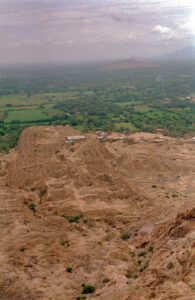
The smaller pyramids at Sipán

are most famous as the burial site of Moche ‘Lords’ who ruled some time between 300 and 700 AD.


![]()
![]()

There, we met our first Peruvian hairless dogs.

Next, we headed inland, back into the foothills of the Andes. It was a dramatic change from the coastal desert. The roads had been badly damaged by floods and landslides following recent, torrential rain. We camped for two nights in the hills above the town of Cajamarca;


where we visited the Cathedral and the Cuarto del Rescate (the’Ransom Room’).

The Conquistador Pizarro imprisoned the last Incan Emperor, Atahualpa, in this room. Atahualpa offered to fill the room with gold up to a line on the wall as high as he could reach as ransom for his release.

The Inca people did this and Pizarro duly had Atahualpa garotted.
We finished our day at the Baños del Inca – where legend has it that Atahualpa bathed.

It took us five hours along a rutted, pot-holed track, to drive the 100 km to Celendin.
![]()
![]()
![]()

We continued east through a high pass that took us over the continental divide

and down to the Rio Maranon; which flows north and then east to merge with other rivers that form the Amazon.

20 km east of Balsas a landslide had carried away a 100-metre section of the track. We picked up five travellers who were trapped on the other side of the landslide and gave them a lift back to Celendin.
We made the bumpy drive back to Cajamarca. Close to town, we encountered a group of men re-erecting a fallen tree.

We never found out why but, when they told us they were off-duty police officers, I offered to help.


Next day it took us 14 hours to reach Chilete. A swollen river had washed the road away after Magdalena.

We were stuck for seven hours in a long queue of lorries

while a new track was bulldozed through the mud.
We were glad to head back to the coast, stopping at El Brujo

to visit Huaca Cortada,

where the guard gave us an unofficial tour of one of the tiered temples, with its painted friezes.

While we were spending a couple of hours on the resort beach at Huanchaco, somebody tried to break into our vehicle. We decided to spend the night parked outside El Commisario (the police station).
We spent the next day at Chan Chan on the outskirts of Trujillo.


The capital of the Chimor empire from 900 to 1470, Chan Chan was the largest pre-Columbian city in South America. It once covered 20 square km. An out-of-work archaeologist guided us around one of the palace compounds.

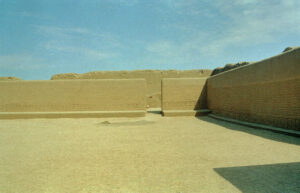

Back in Trujillo, we spent an hour at the Casinelli Museum; with its wonderful, private collection of Moche ceramics.

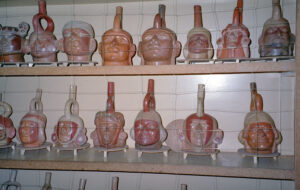
![]()
![]()
![]()
![]()

On our way out of town next day, we visited the Moche pyramids, Huacas del Sol y de la Luna,

with their brightly painted friezes.

We continued through a desert landscape;


stopping at the 3,500 year-old Sechin temple – with its grizly, relief carvings of entrails and severed heads and limbs –



on our way to Casma.
From there, we turned inland again, taking a dirt road that climbed back into the Andes, up a valley beside a cascading stream,


culminating in the 4,200 metre high Punta Callan Pass;

with its view of the snow-capped peaks of the Cordillera Blanca.
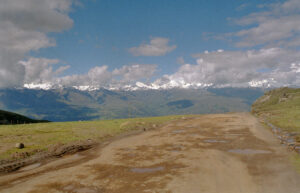

We continued down the winding, dirt road to spend a couple of days at Huaraz; before continuing east on a very poor road,

and through a rocky tunnel, to visit the ruined temple complex at Chavin de Huantar;



with its warren of tunnels and galleries.

![]()
![]()
![]()

While taking a circuitous route back to the coast, we became lost in a snowstorm as we approached the huge Antamina mining complex. The mine guards allowed us to use the mine’s private asphalt road to get us back to the 4,700 metre high Yanshallah Pass
![]()

and onto the long descent to Pativilca. From here, it was an easy drive to Lima, the capital of Peru; where we spent five days.
The rough, dirt roads had taken their toll on our vehicle. We spent a day finding replacements for two shredded tyres and had the Landrover agent check the suspension and steering. That still left us time to visit the Playa de Armas in the city centre



and spend Good Friday in the Miraflores district of the city.
From Lima, we continued south

to the Paracas National Reserve, where we camped a Athens Beach;

not far from Cathedral Rock.

Although set in one of the driest deserts in the world,


Paracas has a coastline that is rich in marine life.

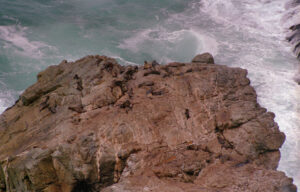
230 km further south,

we took an early morning flight in a single-engined plane to view the Nasca lines;


before driving back into the Andes once more – headed for Cusco.
We were held up at Abancay by roadworks and camped in the grounds of a small hotel.

Next day, we completed the drive over a high pass and down into the Sacred Valley north of Cusco.

Cusco

was once the capital of the Inca empire. Many of the houses still have Inca stone walls up to their first floor.

Set on a hill-top overlooking Cusco,


the fort at Sacsayhuamán has walls of massive stones fitted perfectly together without mortar.


At the shrine of Tambomachay, the Incas channeled water from springs through the masonry.

Pisac is a small farming town with cobbled streets and Spanish colonial houses – some built on Incan foundations. We arrived in time for the Sunday market.


There are the ruins of a large Incan religious complex on the a hillside outside of the town.

![]()

![]()
![]()

![]()
From Pisac, we drove on to Ollantaytambo;

where we visited the ruins of the nearby Incan royal estate.


Leaving Danielle in a hotel at Ollantaytambo, I (Paul) took the train to ‘Km 88’, the start of the Inca Trail. I was lucky that this was the last year that people were allowed to undertake the four-day walk unaccompanied, and carrying their own tent.
The trail, which follows the route of an Incan road, starts at an altitude of 2,500 metres; following a small river upstream through woodland,

before climbing more steeply to meadows above the treeline.

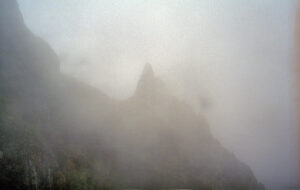
The second day began with a tough 600 metre climb over the first and highest pass on the trail,

before passing an oval Incan watchtower perched over a canyon;

on the way to Runkurakay. I visited Sayacmarca, a ruined peublo on the edge of a cliff;

before camping at Conchamarca on a small bluff with spectacular views over distant, snow-capped peaks.


and down onto the tops of clouds.

On the afternoon of the third day, I visited the terraces and fountains of the ruined Incan town of Wiñay Wayna;
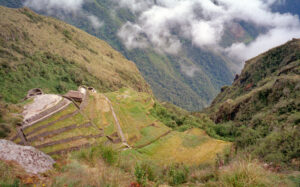
with a good view of the Urabumba River,
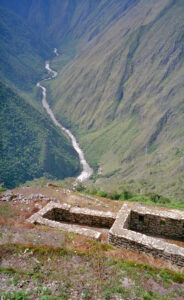
before camping close to a guided group.
I was up at 4 a.m. to reach Intipinku for my first sight of Macchu Picchu to be at sun-rise. Unfortunately, it was a cloudy morning.

When the cloud cleared, the view was spectacular.

I spent the day at the 15th Century Inca citadel,



and took the path up Huayna Picchu; the mountain peak that rises over Macchu Picchu,

before getting the early evening train to rejoin Danielle at Ollantytambo.
After a final day in Cusco, we drove south to Puno, on the shore of Lake Titicaca. We were joined that night by a London bus with a sign ‘London to Tierra del Fuego’. The occupants warned us that Bolivian cocoa farmers were blockading the road. Despite that, on May Day, we crossed the border into Bolivia at Yunguyo.

We watch the programme world’s most dangerous roads and it sounds like you found some treacherous roads here. Very memorable experiences for you.
The driest desert and Nasca lines were very intriguing.
We like the photo of Danielle with the children and the girly llamas with pink decorations.
The photos of the Inca trail are very special and that you were able to see Macchu Picchu.
That photo of Chan Chan really captures my imagination. I have never seen this before, and it is so different from all the pyramids and other Mayan/Incan buildings. Macchu Picchu seems rather overwhelming to me, but Pisac looks friendly – and what a lovely market.
Never heard of the Chimor empire, but what a country of contrasts. Pity Danielle never got to Machu Picchu. You didn’t mention aliens re the Nazca lines…?